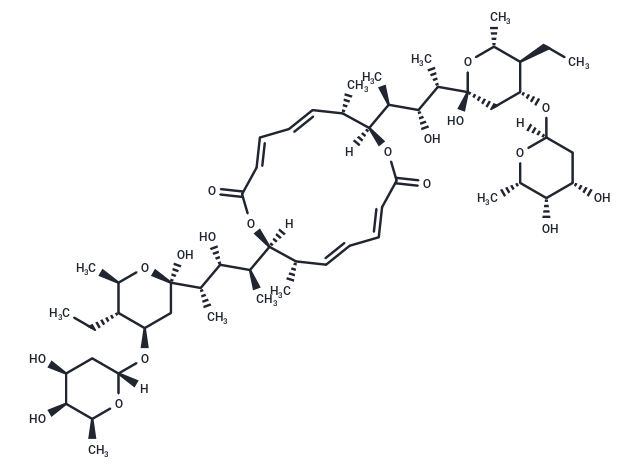Shopping Cart
- Remove All
 Your shopping cart is currently empty
Your shopping cart is currently empty

Elaiophylin (Salbomycin) shows antiprotozoal activity against Plasmodium falciparum K1a and Trypanosoma brucei brucei GUTat 3.1 strains with IC50 of 0.36 μM and 0.45 μM, respectively.

| Pack Size | Price | Availability | Quantity |
|---|---|---|---|
| 1 mg | Inquiry | 35 days | |
| 5 mg | Inquiry | 35 days |
| Description | Elaiophylin (Salbomycin) shows antiprotozoal activity against Plasmodium falciparum K1a and Trypanosoma brucei brucei GUTat 3.1 strains with IC50 of 0.36 μM and 0.45 μM, respectively. |
| In vitro | Azalomycin-B possesses an antibacterial activity against Gram-positive bacteria. The minimum inhibitory concentration (MIC) of Azalomycin-B against Staphylococcus aureus (SG 511, 285 and 503) is 1.52 μM. The MIC of Azalomycin-B against Streptococcus pyogenes is 0.76 μM and 1.52 μM for strains 306A, and 77A, respectively. The MIC of Azalomycin-B against S. faecium A is 3.05 μM. [1] In vitro, Azalomycin-B shows an antibiotic activity as a rumen fermentation efficiency enhancer and also inhibits lactic acid production in the rumen fluid with IC5O of 2.14 μM. [2] Azalomycin-B inhibits P-type ATPases such as the P-type, K+-dependent ATPase from Escherichia coli, without affecting F-type and V-type ATPases at all. [3] Azalomycin-B shows the potent cytotoxic effect on L929 mouse fibroblast cells, K562 human leukemia cells and HeLa cell cultures with IC50 of 0.29 μM, 0.19 μM and 0.29 μg/mL, respectively. [4] Moreover, Azalomycin-B also produces the cytotoxicity in MRC-5 cells with IC50 of 0.85 μM. [5] |
| Cell Research | The adherent mouse fibroblast cell line L-929 is cultured in Eagle's MEM with 0.35 mg/mL sodium bicarbonate, 100 units/mL penicillin/100 μg/mL streptomycin, 10 mM HEPES, and 10% heat-inactivated FBS at 37 °C in culture flasks. The adherent cells are harvested at the logarithmic growth phase after trypsination using 0.05% trypsin in phosphate-buffered saline (PBS) containing 0.02% EDTA. The nonadherent human leukemia cell line K-562, is cultured in RPMI 1640 medium, supplemented with 100 units/mL penicillin/100 μg/mL streptomycin and 10% FBS in culture flasks. L-929 and K-562 cells are inoculated in 0.1 mL culture medium, containing NaHCO3 without HEPES, per well of the 96-well microplates. The plates are previously prepared with dilutions of the Azalomycin-B in 0.1 mL medium. The microplates are kept for 72 hour at 37 °C in a humidified atmosphere containing 5% CO2. The adherent human cell line HeLa is cultured in MEM Eagle with 100 units/mL penicillin/100 μg/mL streptomycin, 10% FBS, and 2 mM l-glutamine in vented culture flasks. The adherent cells are harvested during the logarithmic growth phase after trypsination with 0.4% trypsin in PBS containing 0.02% EDTA. These cells are seeded with in 0.1 mL culture medium per well of the 96-well microplates. HeLa cells are preincubated 48 hours without Azalomycin-B. The dilutions of Azalomycin-B are carried out on the monolayer of HeLa cells after preincubation time. After incubation, the monolayer of the adherent L-929 and HeLa cells are fixed by glutaraldehyde and stained with a 0.05% solution of methylene blue for 15 minutes. After washing the stain is eluted by 0.2 mL of 0.33 N HCl in the wells. The optical densities are measured at 630 nm in a Dynatech MR 7000 microplate reader. After incubation, the K-562 cells are analyzed using an electronic cell analyzer system CASY 1 and software CASYSTAT for determination of IC50 values. The IC50 values are determined by integrated software CASYSTAT. (Only for Reference) |
| Alias | Salbomycin, Gopalamicin, Efomycin E, Azalomycin B |
| Molecular Weight | 1025.27 |
| Formula | C54H88O18 |
| Cas No. | 37318-06-2 |
| Relative Density. | 1.31g/cm3 |
| Storage | Powder: -20°C for 3 years | In solvent: -80°C for 1 year | Shipping with blue ice. | ||||||||||||||||||||||||||||||
| Solubility Information | H2O: <1 mg/mL Ethanol: 5 mg/mL (4.88 mM), Sonication is recommended. DMSO: 49 mg/mL (47.79 mM), Sonication is recommended. | ||||||||||||||||||||||||||||||
Solution Preparation Table | |||||||||||||||||||||||||||||||
Ethanol/DMSO
DMSO
| |||||||||||||||||||||||||||||||

Copyright © 2015-2025 TargetMol Chemicals Inc. All Rights Reserved.